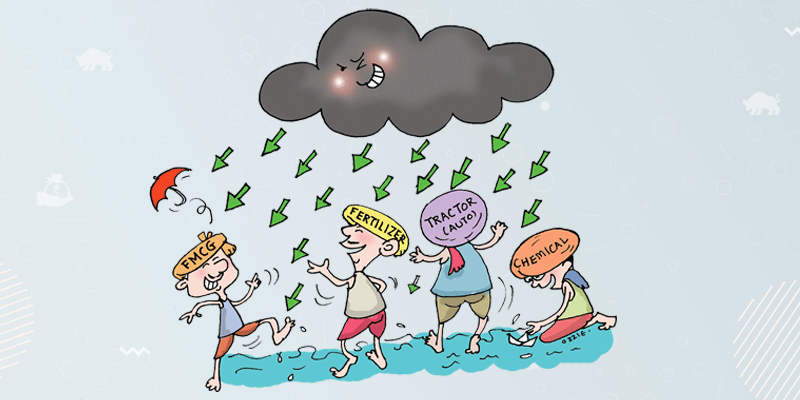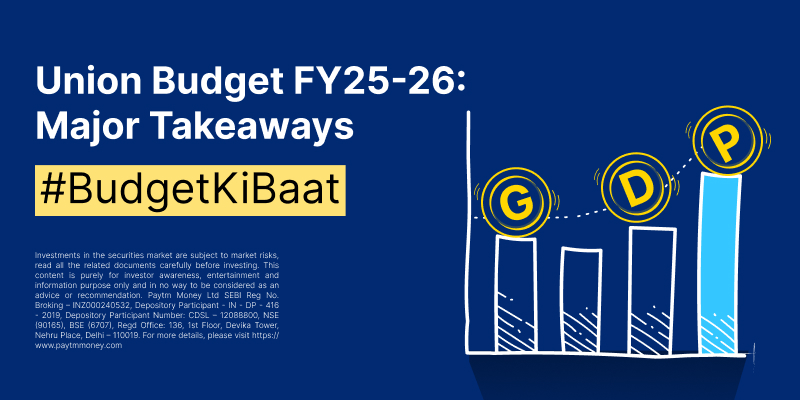Yeh Baarish Ka Mausam, Aur Stock market Ka Connection4 min read
Among other factors affecting stock markets and the overall economy, the monsoon is considered a major deciding factor, given the massive agricultural activity in India.
The southwest monsoon, which typically arrives in June and continues till September, is a crucial source of water supply necessary for agriculture, industry, and households in the country. As per the reports, more than 75% of India’s annual rainfall occurs during this period.
Monsoon rains are critical for the farm sector, which accounts for about 15% of India’s $2.5 trln economy, and employs more than half of the country’s 130 crore people. Let’s see how the monsoon affects the economy.
Monsoon Aur Economy ki Jugalbandi
- Monsoon has a direct impact on agriculture which is dependent on the southwest monsoon. It also has a cascading effect on the demand and supply of other goods such as FMCG, Tractors, Two-Wheelers, Fertilizers, Pesticides, and so on.
- Poor monsoons delay planting and produce smaller yields of crops such as rice, corn, sugar cane, and oilseeds (also known as Kharif crops). That can accelerate food inflation, which ultimately impacts the overall economy.
- Monsoon also impacts groundwater levels, reservoirs, and so on. These are necessary for providing drinking water, irrigation for crops and power, and water for industries is replenished largely on account of the monsoon.
- The impact even ripples overseas, as commodity markets are starved of Indian sugar and rice. India’s agricultural season runs from July to June. The Kharif cropping season is from July to October during the southwest monsoon, and the Rabi cropping season is from October to March (winter). The crops grown between March and June are summer crops.
- Kharif crops include rice, cereals, pulses, soybean, oilseeds, and cotton, which are all water-intensive. As a result, the first few months of rainfall are crucial for Kharif production. Rainfall in September has no impact whatsoever on Kharif sowing, as the season for this ends on August 31.
- Rainfall in September is important for water reservoir levels. These play a vital role for the Rabi crop, for which sowing starts in October. Rabi crops benefit from high moisture levels in the soil, owing to the late spurt in monsoon rains.
- Deficient rainfall might not affect Kharif sowing much, owing to the availability of water from reservoirs. However, it hurts the Rabi sowing season, which is almost completely dependent on irrigation.
Sectors Affected By Monsoon
The majority of the Indian population resides in the rural part of India and the focus of FMCG companies like ITC, Hindustan Unilever, Marico is on the rural demand.
Rural demand is directly connected to the monsoon because, if the farmers in rural India have a good year (crop-wise) they can afford better things which ends up in pent-up demand for FMCG goods, tractors, fertilizers, pesticides, and so on.
As per media reports, the rural theme played out well last year. As monsoon rains bring cheer in rural areas, certain pockets like specialty chemicals or fertilizers-related companies, tractors, consumer names like auto could continue to do well this year, say analysts.
However, some sectors like cement, infrastructure, building, etc. are negatively affected due to monsoon as construction activity is halted in the months of monsoon resulting in sluggish performance.
IMD Predictions on Monsoon 2021
According to a press release issued by Indian Meteorological Department on June 1, it has predicted an overall normal monsoon in India. As per the weather department, the country is likely to experience 101% rainfall during the monsoon season.
The IMD has forecast that the monsoon is likely to be above normal in central India, normal in North and South India, and below-normal in Northeast India. In Northwest India, monsoon rainfall is expected to be normal.
The weather bureau reportedly forecasts rainfall in June at 92-108% of the long-period average.
The southwest monsoon is crucial because rainfall during this period accounts for nearly 80% of the country’s annual precipitation, and nearly two-thirds of the overall Kharif crops’ sown area is completely dependent on it.
Conclusion
Indian companies derive a significant portion of their earnings from rural areas in the country. While some companies are directly dealing in the agriculture market like seeds, agro-chemicals, fertilizers, etc., certain other companies in the FMCG and auto space indirectly benefit from a robust rural economy.
Deficient/excess rainfall leads to crop losses, resulting in lower earnings for farmers, and lower rural demand and sales.
Owing to all these factors, the monsoon remains a major macroeconomic event that is widely tracked by investors, the government, and common citizens, given its substantial impact on the economy and also its unpredictability.
Disclaimer – This content is purely for informational purpose and in no way advice or a recommendation.




